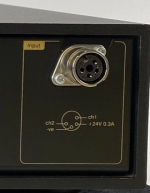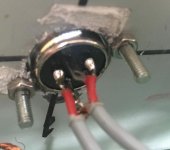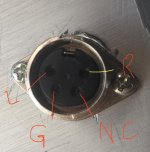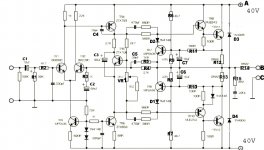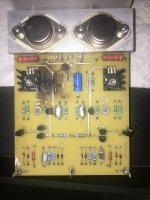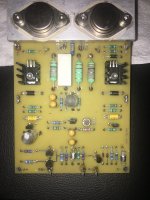It's difficult to explain for me. Let me try:
Regulator of nap250 works for 50-60volts (It's higher than amp circuit(40v)). PSU caps work with regulator voltage. If amp want to use current (power), it use it from 60v charged caps. So, supplied power are larger than 40v psu/40v charged caps? Also, voltage for amp is constant with 40v for stability of amp.
Is this mechanism of regulator of NAP250? I asked before 🙂
Regulator of nap250 works for 50-60volts (It's higher than amp circuit(40v)). PSU caps work with regulator voltage. If amp want to use current (power), it use it from 60v charged caps. So, supplied power are larger than 40v psu/40v charged caps? Also, voltage for amp is constant with 40v for stability of amp.
Is this mechanism of regulator of NAP250? I asked before 🙂
I have been using Jeff Young's boards for almost a year with a separate Pre amp and decided to integrate this clone in my original NAIM system but I have failed.
My original system is NAIM HDX ==> NAC 202 (NAPSC +HICAP)==> NAP 200-- see pic
I have used a 4 pin DIN socket and wired it according to picture 2, leaving +24v pin free.
However all is get is loud ground noise and no music at all. If there was some music I would have thought I am on right path, but it seems not.
Can some one guide me how to rectify this problem?
Thanks
Sajjad
My original system is NAIM HDX ==> NAC 202 (NAPSC +HICAP)==> NAP 200-- see pic
I have used a 4 pin DIN socket and wired it according to picture 2, leaving +24v pin free.
However all is get is loud ground noise and no music at all. If there was some music I would have thought I am on right path, but it seems not.
Can some one guide me how to rectify this problem?
Thanks
Sajjad
Attachments
I think you have to use 24v for pre., which is coming from amp.. If not off course 🙂
ch1, ch2 for input, ground&negative v. for -ve & positive for positive v for pre.
ch1, ch2 for input, ground&negative v. for -ve & positive for positive v for pre.
Last edited:
you are right, that is why I left that pin when wiring, still no luck. I would appreciate any help regarding this issue.
Thanks
Thanks
It looks like you have G and 24V swapped (G is on the right when viewing the front of the plug, but on the left when viewing the back).
I will double check it tonight after work and post a more clear picture of connections.
Thank you both for taking the time to reply, appreciate it
Sajjad
Thank you both for taking the time to reply, appreciate it
Sajjad
Indeed, I had connected ground wire to 24V pin, silly me 😱
Lots of respect to this community for helping people like me

BW
Sajjad
Lots of respect to this community for helping people like me

BW
Sajjad
Well my joy was short lived, last night the whole thing went in flames.
Upon investigation it seems that 220 OHM resistor on positive supply rail burnt and then took the 10UF capacitor with it.
I will remove most of components and check but I would appreciate any guidance on what would have initiated this disaster in the first place??
Please help!
Thanks
Upon investigation it seems that 220 OHM resistor on positive supply rail burnt and then took the 10UF capacitor with it.
I will remove most of components and check but I would appreciate any guidance on what would have initiated this disaster in the first place??
Please help!
Thanks
Attachments
It looks like you amp shorted out the power supply.Well my joy was short lived, last night the whole thing went in flames.
Upon investigation it seems that 220 OHM resistor on positive supply rail burnt and then took the 10UF capacitor with it.
I will remove most of components and check but I would appreciate any guidance on what would have initiated this disaster in the first place??
Please help!
Thanks
Indeed, it looks like it, I removed the transistors and every single one of them is burnt. Struggling to find the original BDY58, any recommendations?It looks like you amp shorted out the power supply.
It's a switching type transistor, as specified in all early (i.e. pre chrome-bumper series) amps. There aren't many bipolar switching types still available in a TO3 package but BUV20 has been suggested as a suitable substitute for BDY56 and 58 in Naim amps for several years now.
Check this thread: https://www.diyaudio.com/community/threads/buv20-good-or-bad-opportunity.345497/
Check this thread: https://www.diyaudio.com/community/threads/buv20-good-or-bad-opportunity.345497/
Last edited:
I sourced lot's of new old stock BUV20, BUX20, BDY58 etc., also desoldered ones, all of them sounded bad (i.e. distortion). Forget them and use MJ15003, they sound very good!
If you're trying to build a clone, build a clone rather than modifying its parts specs before you even hear what the original may have sounded like. If you don't like the sound of the original design as you built it (remember, Naim's first products were an instant hit back in the day) then investigate where you went wrong and change it to be closer to the original in the component specs at least.
Obviously, if you don't like the original sound or Naim sound even at its best, then build something else entirely. Class A, D, or hybrid - whatever floats your boat. My own experience of the original NAP250 (way too expensive for my pocket) was a revelation. Nothing in my collection of amps touched it then because it had that infectious musicality and engagement. Sure, times have changed since but that same product with its original BDY58s still doesn't sound bad at all - even near 40 years on. I'm well aware that Avondale cloned the NAP design using MJ15003 and once made finished amps too. They still offer kits of finished boards and updated designs for their following of DIY fans but their market is limited by small scale production costs and is really only local UK. I've only heard their sound a few times myself but I would say its smoother than Naim's sound of the period and lacks a little life. If that's what you prefer, go the NCC200/300 way and forget the Naim sound and clones as jpk may be suggesting.
On the other hand., if you're starting with Chinese clone kits and boards, I can well understand the frustration of getting nothing but poor sound. There have been improvements over the years - sometimes genuine semis and great PCBs are offered too but most of the cheap kits are just a waste of time and money because they don't follow the design in the details - just generic, unmatched semis as they come, with a minimal circuit/ PCB. If you don't need to use original TO3 semis though, Sanken's LAPT transistors are by far the better way forward, not the slow old TO3 types from Onsemi, ST micro etc, nor switching types, NOS relics etc.
Obviously, if you don't like the original sound or Naim sound even at its best, then build something else entirely. Class A, D, or hybrid - whatever floats your boat. My own experience of the original NAP250 (way too expensive for my pocket) was a revelation. Nothing in my collection of amps touched it then because it had that infectious musicality and engagement. Sure, times have changed since but that same product with its original BDY58s still doesn't sound bad at all - even near 40 years on. I'm well aware that Avondale cloned the NAP design using MJ15003 and once made finished amps too. They still offer kits of finished boards and updated designs for their following of DIY fans but their market is limited by small scale production costs and is really only local UK. I've only heard their sound a few times myself but I would say its smoother than Naim's sound of the period and lacks a little life. If that's what you prefer, go the NCC200/300 way and forget the Naim sound and clones as jpk may be suggesting.
On the other hand., if you're starting with Chinese clone kits and boards, I can well understand the frustration of getting nothing but poor sound. There have been improvements over the years - sometimes genuine semis and great PCBs are offered too but most of the cheap kits are just a waste of time and money because they don't follow the design in the details - just generic, unmatched semis as they come, with a minimal circuit/ PCB. If you don't need to use original TO3 semis though, Sanken's LAPT transistors are by far the better way forward, not the slow old TO3 types from Onsemi, ST micro etc, nor switching types, NOS relics etc.
Thank you both for the guidance. I like NAIM sound so will at least try to get close to the original.
I have ordered few BDY58 from eBay, lets see I am lucky enough to get genuine parts. I will keep you posted.
BW
Sajjad
I have ordered few BDY58 from eBay, lets see I am lucky enough to get genuine parts. I will keep you posted.
BW
Sajjad
Yes, Naim's NAP250 has linear regulators on PCBs that look similar to the power amps as Jeff's clone shows too.Is this mechanism of regulator of NAP250? I asked before 🙂
The more popular original Naim product details are revealed on these pages archived at Pinkfishmedia forum: http://www.acoustica.org.uk/t/naim/power_amps.html Yes, the phase compensation components are different for each model but I'd suggest this may have been the result of tweaking (by ear) rather than just calculated values. In any case, the networks can be removed with little or no functional consequence.
In LTspice I made a wrong connection. I added a cap as 20-30pf in the schematic. Now, HF resonance decreased to zero, THD increased little bit.
What happened there, and is this usable? (For HF resonance, increase Q6's Hfe)

What happened there, and is this usable? (For HF resonance, increase Q6's Hfe)
- Home
- Amplifiers
- Solid State
- NAP250 clone

